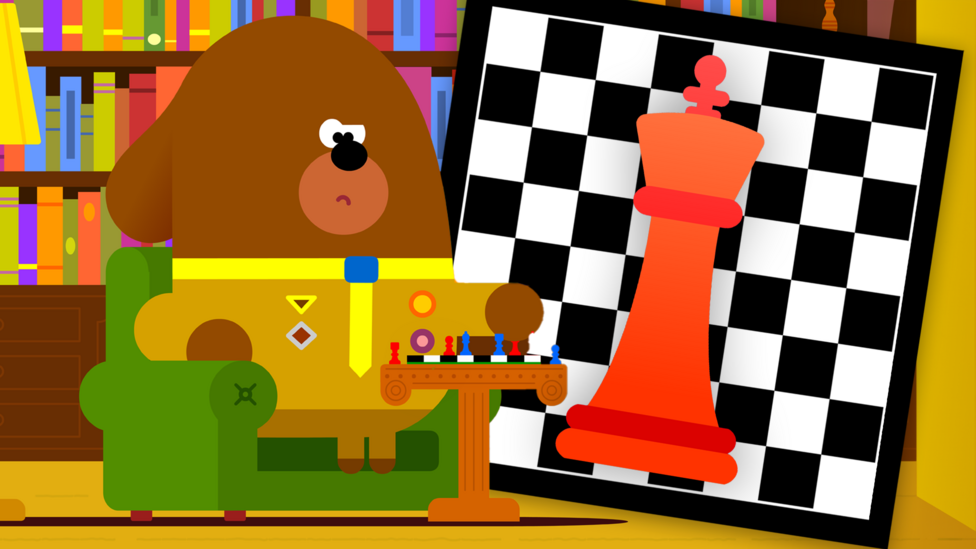Learn to play chess with Hey Duggee
Discover the magic of chess with your family, as Duggee and the Squirrels take you through the basics.

Chess and your child
You might think chess is too advanced for your child, but it's actually a great game to teach them some basic life skills. Critical thinking, problem-solving, strategy, focus and memory skills can all be improved with chess. It is also a brilliant opportunity for your little one to learn about winning and losing a game, and coping with the emotions that accompany those milestones. Chess is also a global game, which promotes the social skills of fairness, inclusion and mutual respect.
If you've watched the Hey Duggee episode 'The Cheerleading Badge' you might remember the Squirrels cheered Duggee on to become a grand chess master! Perhaps your child was curious about the pieces, the drama or the competition itself. You can use this resource to help explain the basics of chess and introduce them to one of the oldest games in the world.
What is chess?
Chess, sometimes called the game of kings, is a game played between two people. They take turns and try to successfully attack the other player’s ‘king’, and if that happens, the king must give up and the attacking player wins. It’s a fun but challenging game, a real headscratcher, and it is played all over the world because it is so old and popular.
The aim of the game is to leave your opponent’s king with no other choice but to give up. When he can’t run away and none of his pieces can rescue him, he will be defeated. Easy, right?
Not so fast! Both players have game pieces they can use to block or destroy their opponent’s plans.

The chess board
It might look like a kitchen floor to the untrained eye, but the chess board is one of the most iconic patterns. There are 64 squares, 32 white and 32 black. Some boards use other colours but often they will be a lighter and a darker colour.
Now, imagine you have two armies facing each other... These are your pieces! There is usually a black set of pieces and a white set of pieces on opposite sides of the board. This will be the site of an epic battle! The white pieces traditionally go first, but if you have other colours you can flip a coin.
The pieces can be compared to members of an army. They all have special ways of moving, and they can all attack the opposite player’s pieces - if they have the chance!
Play chess with your child
Can you tell it was invented many years ago, when kings and knights would fight on battlefields? Over the years, this game has been used to teach logic, and the earlier a person starts, the more it will help them with critical thinking and planning ahead, a really helpful skill as they grow up. Chess is one of the best games to play with your child. But where do you start?
Let’s start simple.
Learn the right moves
So now we know about the different pieces and what they look like. But how do we use them to win the game?
To win the game, you must invade an opponent’s squares and capture their pieces and to do that, they need to move.
What is "check"?
Check happens when your opponent’s move puts your King in danger — meaning the King could be captured on the next turn if you do nothing.
The game does not end here. You must make a move to get out of check by:
Moving the King to a safe square.
Blocking the attack with another piece.
Capturing the attacking piece.
If you can’t do any of these, then it becomes checkmate (game over).
What is "checkmate"?
Checkmate is a move that ends the game. It happens when:
The King is in danger (called "check").
The King cannot escape — there’s no move that can block the attack, capture the attacking piece, or move the King to safety.
Once a player puts the opponent’s King in checkmate, the game is over and that player wins.
If that happens, the King has surrendered and the player may knock the King over to show that he has been captured, just as Colombo Jones does when he loses the game to Duggee.
Duggee's Grand Master Chess Quiz
If you and your child found the last two quizzes too easy, you might enjoy this final chess challenge!
In this quiz, you will attempt to:
Defend your King
Capture your opponent's pieces
Make a checkmate.
If you're still unsure, just look at everything you've learned already!
How to recognise different chess pieces
How each chess piece moves
Now let's put all this learning to the test and see if you can surprise yourself - and help your child surprise themselves too!
Want more chess on CBeebies?
The rules and roles of the pieces in chess can be tricky to master, see Bluey and Bingo’s take of the game as they play against Bandit, their dad, with a quick game of chest. Ahem, chess.
Watch Maddie & Triggs episode Check Mates as Maddie starts at chess club and makes a new friend.
More games from Hey Duggee
You can play the Snap game or Three in a Row game with Hey Duggee to introduce your child to table top games.
If your little one prefers stickers and dress up, try Find the Stickers with Duggee or play Fancy Dress Up with Duggee.
Earn Hey Duggee badges by playing interactive games:
Come and earn your Picnic Badge with Duggee and the Squirrels.
Learn and play to gain your Busy Day Badge with Duggee and the Squirrels.
Join Duggee and the Squirrels on their voyage to the bottom of the sea and as they follow a secret treasure map!